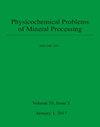碳氢化合物污染砂的浮选动力学跟踪:纸浆颜色随时间变化的图像分析
IF 1.3
4区 工程技术
Q4 CHEMISTRY, PHYSICAL
引用次数: 0
摘要
环境中的碳氢化合物污染是一个重大挑战。浮选修复是解决这一问题的有效途径。这种方法需要分离疏水性化合物,如土壤碳氢化合物,通过将空气引入含有指定用于修复的土壤浆的搅拌反应器中。采用5l间歇式浮选池对浮选条件进行了评价。这些实验的重点是获得不同有机混合物的浮选动力学,包括小于150µm的细砂。实验设计包括气流、碳氢化合物浓度和表面活性剂用量。该研究使用了有机浓度高(8和17克/升)的稀释纸浆(3%固体)。通过开发一种基于矿浆颜色和图像处理软件的创新技术来测量浮选动力学。根据比尔-朗伯定律,这种技术有助于追踪浓度随时间的变化。随后,使用矿物浮选中常用的动力学模型(包括First Order、Kelsall和Klimpel模型)对结果进行了调整。这一综合分析旨在阐明潜在的现象,并评估工业规模实施的潜力。实验结果表明,加样回收率可达86.9%,一级动力学常数为0.73 (1/min)。值得注意的是,气体流速和表面活性剂的加入对该常数都有实质性的影响,这与本研究观察到的现象一致。此外,该研究揭示了碳氢化合物浓度对动力学的影响,表明了控制碳氢化合物输运的另一种机制。本文章由计算机程序翻译,如有差异,请以英文原文为准。
Flotation kinetic tracking of sand contaminated with hydrocarbons: image analysis of pulp color changes in time
Hydrocarbon contamination in the environment represents a significant challenge. Soil remediation by flotation has been proposed as an effective approach to address this issue. This method entails the separation of hydrophobic compounds, such as soil hydrocarbons, by introducing air into a stirred reactor containing the soil pulp designated for remediation.
Experiments were conducted using a 5 L Batch flotation cell to evaluate operating conditions. These experiments focused on obtaining flotation kinetics with different organic mixtures, including fine sands measuring under 150 µm. The experimental design encompassed airflow, hydrocarbon concentration, and surfactant dosage. The research utilized a diluted pulp (3% solids) with a high organic concentration (8 and 17 g/L).
Flotation kinetics were measured by developing an innovative technique based on pulp colour and image processing software. This technique facilitated the tracking of concentration changes over time under Beer-Lambert's Law. Subsequently, the results were adjusted using kinetic models commonly employed in mineral flotation, including the First Order, Kelsall, and Klimpel models. This comprehensive analysis sought to elucidate the underlying phenomenology and assess the potential for industrial-scale implementation.
The laboratory findings indicate the possibility of achieving recoveries of up to 86.9%, with a first-order kinetic constant of 0.73 (1/min). It is noteworthy that both the gas flow rate and the addition of surfactant exert substantial influence on this constant, consistent with the observed phenomenology of this study. Additionally, the research unveiled the impact of hydrocarbon concentration on kinetics, suggesting an additional mechanism governing hydrocarbon transport.
求助全文
通过发布文献求助,成功后即可免费获取论文全文。
去求助
来源期刊

Physicochemical Problems of Mineral Processing
CHEMISTRY, PHYSICAL-MINING & MINERAL PROCESSING
自引率
6.70%
发文量
99
期刊介绍:
Physicochemical Problems of Mineral Processing is an international, open access journal which covers theoretical approaches and their practical applications in all aspects of mineral processing and extractive metallurgy.
Criteria for publication in the Physicochemical Problems of Mineral Processing journal are novelty, quality and current interest. Manuscripts which only make routine use of minor extensions to well established methodologies are not appropriate for the journal.
Topics of interest
Analytical techniques and applied mineralogy
Computer applications
Comminution, classification and sorting
Froth flotation
Solid-liquid separation
Gravity concentration
Magnetic and electric separation
Hydro and biohydrometallurgy
Extractive metallurgy
Recycling and mineral wastes
Environmental aspects of mineral processing
and other mineral processing related subjects.
 求助内容:
求助内容: 应助结果提醒方式:
应助结果提醒方式:


